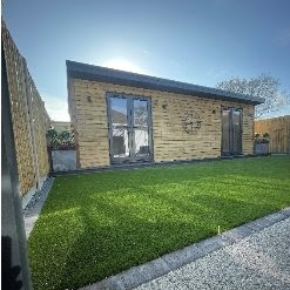
Green home renovations: a guide to creating sustainable living spaces
With sea levels rising and visibly extreme weather conditions fast becoming an inherent part of our daily lives, the need to reduce our environmental impact is more prominent than ever.
And whether it’s for anthropocentric, biocentric or ecocentric reasons, the seemingly endless benefits of going green mean that more and more of us are looking to renovate our homes to transform them into more eco-friendly buildings.
From reducing your carbon footprint to adding value to your home, fine-tuning an existing property in an aim to reduce its environmental impact can save you money in the long term – which is why so many of us are choosing to give our properties the renovations that they deserve.
While the initial investment that comes with home improvement can seem off-putting, ensuring that your abode is environmentally-friendly will soon pay off – and whether you’re in a rush to get started or are concerned about a poor credit score, no credit check loans mean that you can reduce the time you’ll have to wait for approval.
1. Upgrade to greener materials
Whether it’s a large-scale two-storey extension or you’re just treating a section of your home to some interior design updates, considering which materials you’ll use is a must for maximising sustainability in this space. While a straw bale building may be considered to be a thing of the past, the affordability and high levels of insulation that come with this material makes it an attractive choice for anyone that’s looking to go green with their home design.
Similarly, the high tensile strength and fast-growing nature of bamboo makes it a versatile choice for the construction industry. Whether you opt for a bamboo building frame or clad the floor in durable bamboo flooring, making a conscious effort to incorporate renewable resources into your home means that you can achieve the same high standard that you’ve come to expect – but with far greener consequences.
2. Embrace passive design principles
Passive design principles are centred on taking full advantage of the climate in order to maintain comfortable temperature conditions in the home – meaning that you can maximise self-sufficiency. Significantly reducing the need for heating and cooling systems in a property, this design will not only reduce the impact you make on the environment, but you could end up saving money on utility bills too.
For areas with typically cooler weather conditions, incorporating materials with high thermal mass – such as concrete, bricks and tiles – into the passive design of your home refurbishment means that you can retain more heat for significantly longer. This means you can lower your overall consumption of auxiliary heating and therefor reduce energy bills.
3. Implement new, sustainable features
Replenishing non-renewable energy sources has, unsurprisingly, become a growing concern in recent years – and with research suggesting that fossil fuels could run out in the next 70 years, implementing sustainable alternatives into our homes is essential.
Installing solar panels, wind turbines or hydro power generators into your home might come with an initial investment, but by taking energy production into your own hands, you could significantly reduce the amount that you depend on fossil fuels. In turn, any surplus energy that you generate could be sold back to the National Grid through their Feed-in Tariff scheme.
4. Reduce water wastage with innovative technology
With available freshwater making up less than 1% of the world’s water, supplies of this vital resource are becoming increasingly depleted – and with energy-intensive filtering processes requiring non-renewable fossil fuels, reducing the volumes of water wastage is crucial. While some of us are switching from baths to water-conserving showers, it’s toilet flushing which typically consumes the highest proportion of water in the home.
Today’s dual flush toilets might use just 3-6 litres of water, as opposed to a typical 13-litre flush, but with continuous developments in modern technology, there’s even more savings to be made. With rimless models designed to improve the flushing power, using as little as 2.5-4 litres of water, updating your toilet can mean you significantly reduce your carbon footprint. Similarly, the water-efficient toilet model which comes with a tap and basin integrated into the sink means that you can control water usage, while saving space in your bathroom.
Whether you extend your property with passive design principles in mind or update the insulation system with renewable materials, there are no shortage of ways that you can go green at home. And with the opportunity to save money as well as the environment, there’s every reason to create your own sustainable living space.
Latest news

29th April 2025
Senior pledges to ‘bee’ part of the solution with new biodiversity initiative
Senior Architectural Systems has installed its first on-site beehive, marking another step forward in its commitment to sustainability and biodiversity.
Posted in Articles, Building Industry News, Building Products & Structures, Building Services, Curtain Walling, Doors, Glass, Glazing, Innovations & New Products, news, Restoration & Refurbishment, Retrofit & Renovation, Sustainability & Energy Efficiency, Walls, Windows
29th April 2025
West Fraser range delivering key benefits for South-East carpentry company
An experienced carpenter and building site manager who has recently set up his own company is using high performance panel products from the West Fraser range.
Posted in Articles, Building Industry News, Building Products & Structures, Building Systems, Case Studies, Garden, Restoration & Refurbishment, Retrofit & Renovation, Sustainability & Energy Efficiency, Timber Buildings and Timber Products
29th April 2025
CPD Courses Available Online From Ecological Building Systems
Ecological Building Systems, a leading supplier of natural building products for sustainable construction, has revealed its comprehensive CPD programme for the year ahead.
Posted in Articles, Building Industry Events, Building Industry News, Building Products & Structures, Building Services, Continuing Professional Development (CPD's), Information Technology, Innovations & New Products, Insulation, Restoration & Refurbishment, Retrofit & Renovation, Seminars, Sustainability & Energy Efficiency, Training, Walls, Waste Management & Recycling
29th April 2025
WindowBASE launches new prospect databases at FIT Show
Visit WindowBASE at the FIT Show to see first-hand how it helps companies find new customers – the company is launching an easy-to-use, intuitive platform on Stand G16 at the NEC Birmingham from 29th April – 1st May.
Posted in Articles, Building Industry Events, Building Industry News, Building Products & Structures, Building Services, Doors, Exhibitions and Conferences, Glass, Glazing, Information Technology, Innovations & New Products, Posts, Publications, Research & Materials Testing, Restoration & Refurbishment, Retrofit & Renovation, Windows
 Sign up:
Sign up: 